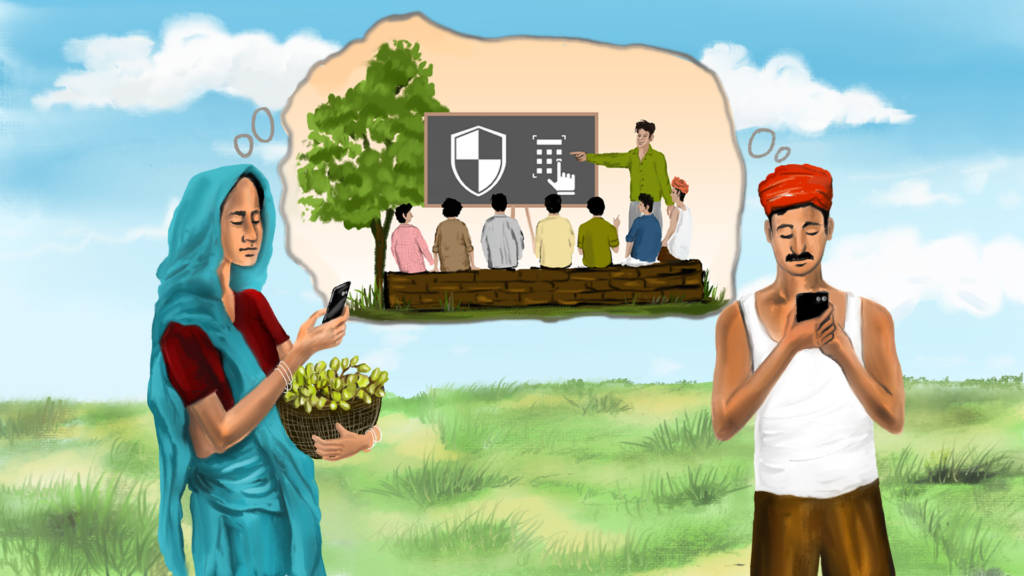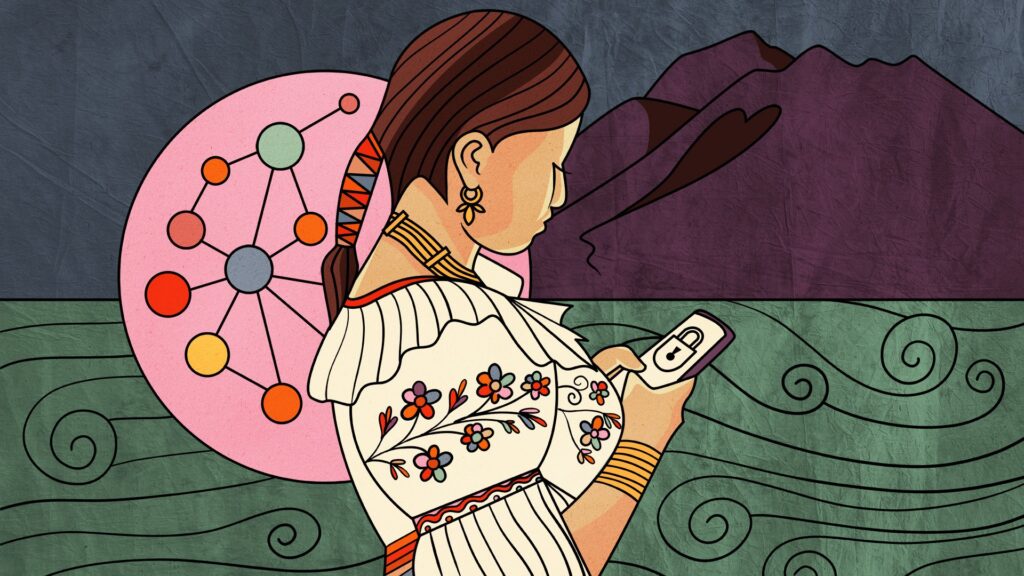
This alarming research finding, uncovered by Indian language activist Amrit Sufi, identifies an urgent challenge that is facing Indigenous language communities globally. The global boom in digital activity has been shaped by privatisation, monopolisation and monetisation of technological infrastructure. As a result, linguistic communities that have faced historical repression are being pushed further to the margins in the digital world. Their exclusion is an outcome of historical legacies, like colonialism, and socio-economic factors, like residing in rural or peri-urban areas, income, gender, race and caste hierarchies. Language activists and researchers from Latin America, Africa and Asia are revealing how these factors have undermined linguistic diversity, which has endangered the digital safety and security of marginalised language communities.
Language dominance in India affects Angika and Odia speaking communities
In Bihar, a state in East India bordering Nepal, Angika speaker and researcher, Amrit Sufi has noticed a shift in how Angika speakers engage with digital devices in the last 20 years. She notes that there has been a rapid rise in mobile device usage, as well as access. This boom in mobile phone and internet access has coincided with a shift in the migration patterns of the youth and what language they choose to speak. Currently, young people are flocking to larger cities in search of better work opportunities, and many young people are choosing to speak Hindi when they are not at home. Leaving home for other regions in India often means that Angika speakers are discriminated against when they speak their language. Their experience of discrimination is not different from speakers of other Indigenous local languages.
Sufi notes that this combination of factors has resulted in young Angika speakers beginning to “abandon their language”. In online spaces, languages like English and Hindi dominate the digital landscape. There is a lack of online content in Angika, whether its educational resources or content for entertainment purposes. This makes it difficult for Angika speakers to engage in their language on digital platforms. Sufi also remarks that this marginalisation has added to a commonly held belief that Angika is inferior to dominant languages like Hindi and English. One of the commonly proposed strategies is to teach people English so that they can access and understand information on digital security. This undermines the need for linguistic diversity online and often bolsters oppressive effects from India’s colonial past.
The supremacy of English in India is a colonial legacy. British colonialism also exploited the caste system in the country to divide different communities even further. The Dalit community was severely impacted by this historical caste-based oppression and the ramifications of that are still visible. For example, young people in the Dalit community gain access to digital devices at a much older age than their peers. This negatively affects their digital know-how and experience on digital platforms, which leaves them more vulnerable to online attacks.
In the East Indian state of Odisha, English and Hindi also dominate digital spaces. Odia is a linguistic powerhouse in Odisha and in neighbouring regions, and Odia speakers have made strides in creating digital media in their language. However, the language still faces the challenge of under-representation in media and digital platforms. Hindi’s dominance in Indian education and popular culture has pushed Odia speakers to engage with content in Hindi and navigate Hindi interfaces. The alternative that is offered for Indian states that do not want to engage in Hindi is English.
The dominance of English on digital platforms is an added barrier for Odia-speaking women. According to researcher and language activist Subhashish Panigrahi, gender inequality is pervasive in the Indian education system and limits the English language literacy of women, especially from lower income areas. Gender disparity also stands in the way of equitable access to mobile devices and knowledge on how to be safe on digital platforms.
Monolinguistic cultures in Latin America impact language diversity in digital spaces

In Ecuador, the Indigenous language of Kichwa is in danger of dying out. The language is no longer being passed down by the older generation and only a minority of families speak the language at home. Young Kichwa people are not using it in digital spaces because of the oral nature of the language. Most Kichwa speakers are not able to write in the language. The lack of documentation of the Kichwa language is an effect of colonisation and has resulted in the domination of the Spanish language in the region.
In the Northern region of Latin America, the Wayúu people are separated by a colonial border that creates a dividing line in the community between Venezuela and Colombia. Speakers of the Wayuunaiki language are also contending with the lack of recognition of oral forms of communication in online spaces. There are limited resources in the Wayuunaiki language which give information about digital security. These resources use simple written language; however, written resources still have a very limited reach in the community.
In the Sierra Sur of Oaxaca, Mexico, Zapotec language activist and researcher Rodrigo Pérez is calling attention to the needs of rural communities in the fight for linguistic and digital rights. Like the majority of the above-mentioned case studies, Indigenous communities in this rural area are deprived of equitable access to the internet, as well as content in their languages. The internet in these areas is prohibitively expensive and of a lower quality. On social media, the dominant language used is Spanish. This monolingual environment is a barrier for other language users to engage actively. In this digital environment and context, Indigenous language users take on a bystander role – passively receiving information, rather than generating their own content that is representative of their communities.
Historical legacies of oppression compound inequality for Indigenous language communities in South Africa
In South Africa, the Apartheid state institutionalised racial segregation and as a consequence, a repression of Indigenous languages, especially in the education system. Post-Apartheid, a progressive Constitution acknowledges the historical damage that relegated Indigenous languages to an inferior position. However, this recognition on a policy level has not translated to the adequate progress of Indigenous languages on a societal level. The digital divide has continued to fuel this marginalisation. There is a structural gap in who has adequate access to digital devices and the internet. Socio-economic inequality has meant that linguistic communities in under-resourced areas are shut out of the global boom in digital resources. This is apparent in South African townships.
During Apartheid, the government built a socio-political and legislative system that ensured the supremacy of English and Afrikaans. There was a structural campaign by the state to devalue Indigenous African languages and those who spoke these languages. The legacy of this is still entrenched in the post-Apartheid landscape of the country. However, previously disadvantaged linguistic communities are speaking out about their challenges to ensure that their languages are better represented, especially in the digital space.
“As a language activist, I realised during the interviews that one of the reasons young people are abandoning their language is that they find it unusable on digital platforms.”
Researcher from the study
In the township of Vaal, the majority of the population speaks Sesotho. Residents have to deal with socio-economic barriers like the lack of job opportunities, poverty, lower incomes, power cuts and internet cuts. Added to this is the lack of Sesotho content available on online platforms. Students in the area are particularly calling for access to study guides, Youtube content and other audiovisual resources in their language. Overall, they believe that there should be an option to switch all digital content into their language.
Ways forward for addressing language marginalisation
What South African students in peri-urban areas are asking for is echoed by Indigenous language communities in rural communities in Latin America and Asia. First and foremost, there is a call for research and discussions around digital security at the community-level to be inclusive of Indigenous language speakers who understand what is happening in their territories. It is necessary to value cultural specificity when creating spaces for expression or knowledge sharing, including acknowledging the nature of communication within Indigenous language communities, which is often through oral or spoken means. Furthermore, in order to address knowledge gaps around digital security, training and other community interventions need to be culturally and linguistically relevant, and may oftentimes require digital literacy components, considering that many people from Indigenous language communities would be unfamiliar with certain technological tools.
Researchers’ recommendations suggest that coordinated approaches across government and civil society hold the means for creating structural change. The internet is a universe designed and created by those that move through it. The online space thus holds an expansive opportunity for transforming the political landscape of language use and development in local community contexts globally. Given the rapid rate of technological development, coupled with increased Indigenous language marginalisation, there is an urgency in prioritising the inclusion of themes, questions, and actions related to linguistic diversity in the broader digital rights and digital security agendas. Building collective mechanisms for the prevalence of Indigenous language representation in every facet of technological use and creation holds the power to dismantle exclusionary language practices and inspire change.
More about Rising Voices’ Digital Security + Language research study:
The project points to the power of participatory research in surfacing the complexity of linguistic rights-related questions in the digital safety and security field, as each researcher approached the topic from a unique starting point in relation to their own experiences and understandings.
This is the fourth post of a four-part series on Rising Voices’ Digital Security + Language research study that explored the intersection of digital security and linguistic rights in collaboration with 18 researchers, from 18 different language communities in Africa, Asia and Latin America.
Read the rest of the series:

